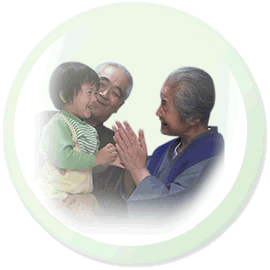|
|
 |
 |
Celebrating long life
The Japanese have the custom of celebrating the long life
of relatives and acquaintances. The best-known celebration
is Kanreki, the 60th birthday. When a person turns 60 years
old (in the age-counting system of Japan, it is actually the
59th birthday), his/her family gives a red vest (or other
auspicious clothing) as a gift. We also celebrate the 70th,
77th, and 88th birthday.
 History History
This custom was imported from China during the Nara Period
(710-784), and the system was almost complete by the Muromachi
Period (1336-1568). In those days, it was said that "Man's
span of life is but fifty years" and people had shorter
lives. They celebrated the 40th birthday and every tenth year
after this. As human life becomes longer, the system changes
and now we celebrate ages over 100.
Chaju (Celebration of the "tea" age) means 10
+ 10 + 88
What age does the "Chaju" celebrate? The answer
is 10 + 10 + 88 = 108. When we break down the Chinese character
for "tea," it consists of three components: two
of them represent the meaning of "ten" and one represents
"eighty-eight." The 108th birthday is a celebration
of a very long life, and it matches the healthy image of tea.
If you drink green tea, with its many healthy properties everyday,
you may be able to celebrate your 108th birthday.
Tea as a present
We recommend tea as a present in celebrating long life in
addition to the 108th birthday. Choose the most premium tea
and convey your message "Have tea and live long."
This kind of celebration party is normally held on birthdays,
New Year's Day, or Respect-for-the-Aged Day. Put a card with
the word "Celebration" on it.
|
 |
|